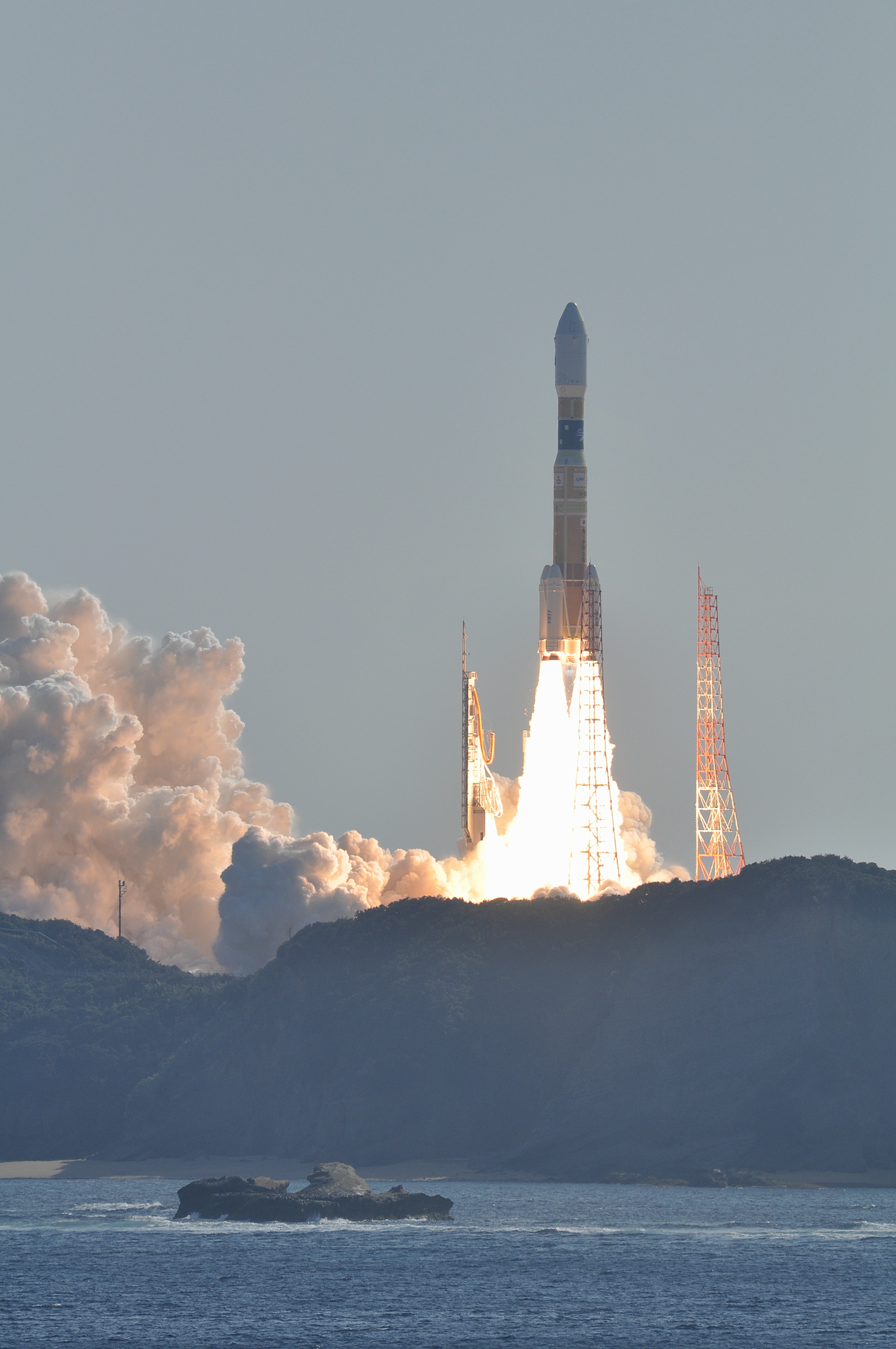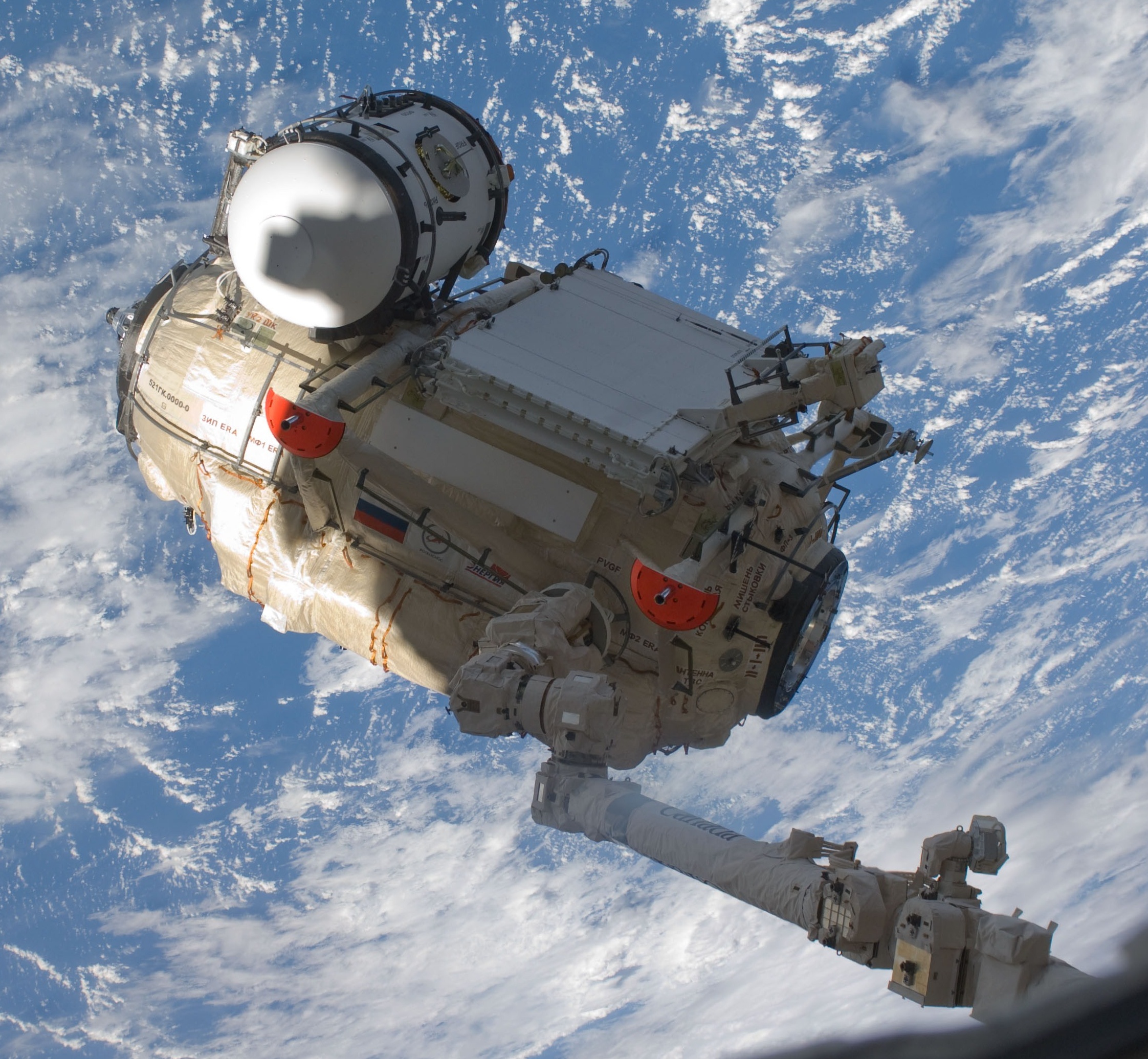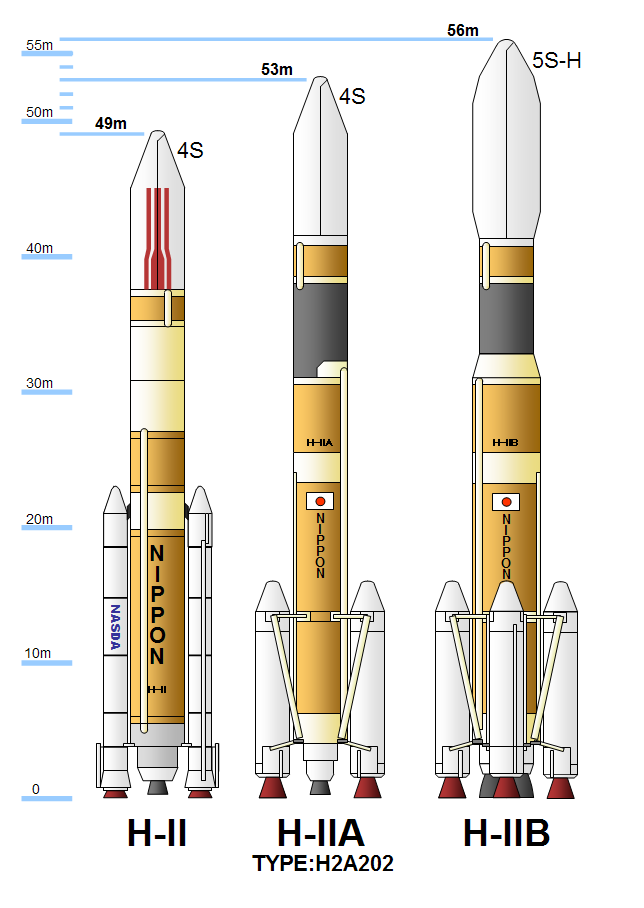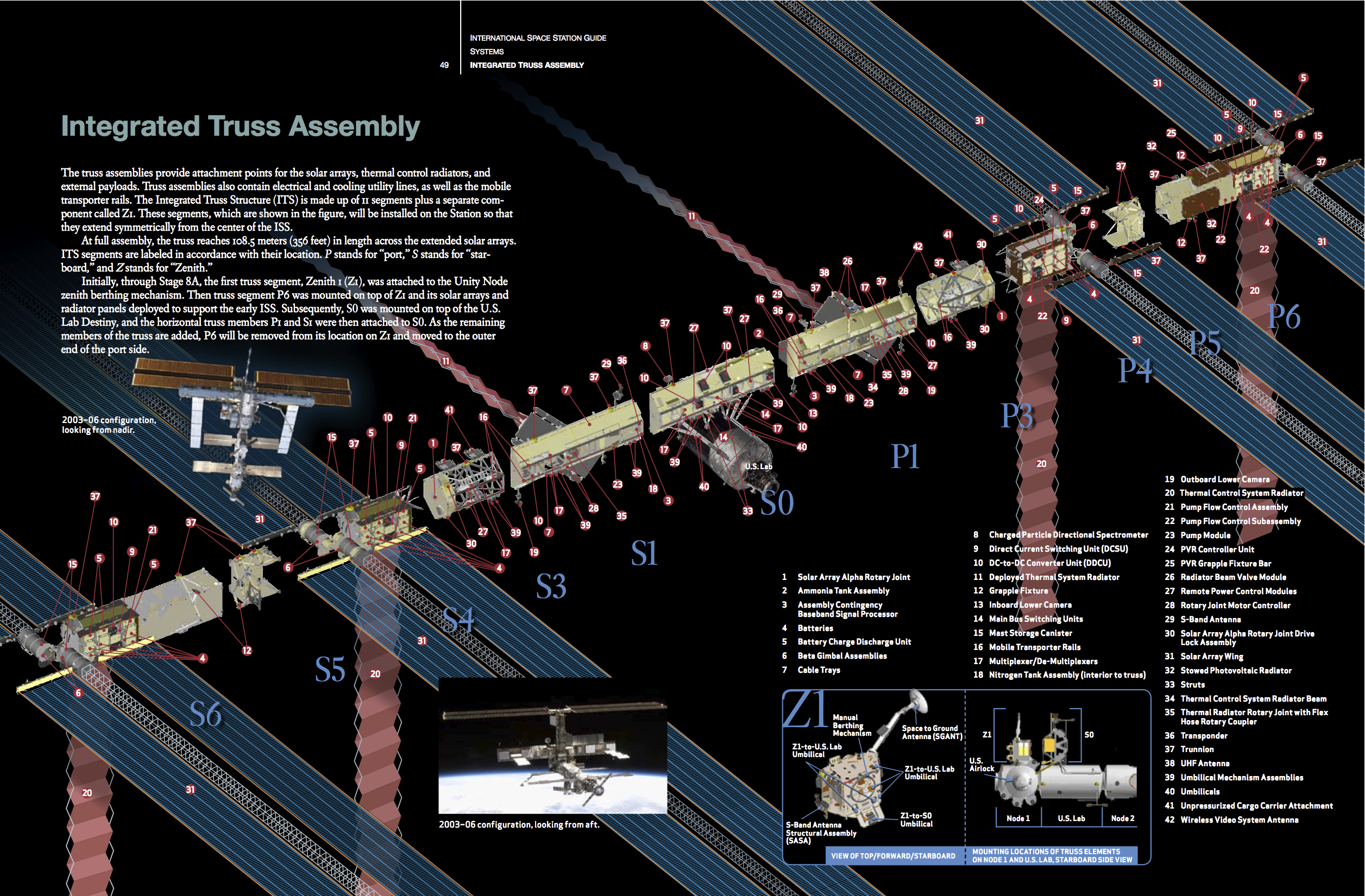|
Kounotori 4
Kounotori 4, also known as HTV-4, was the fourth flight of the H-II Transfer Vehicle, an uncrewed cargo spacecraft launched in August 2013 to resupply the International Space Station. It launched from Tanegashima Space Center aboard H-IIB No. 4 (H-IIB F4) rocket on 3 August 2013 and connected to ISS by 9 August 2013; it carried of cargo. Kounotori 4 undocked on 4 September 2013 and was destroyed by reentry on 7 September 2013. Specifications Major changes of Kounotori 4 from previous HTV are: * Although the previous Kounotori 3 used reaction control system (RCS) thrusters by IHI Aerospace, Kounotori 4 uses the RCS manufactured by Aerojet, similar to HTV-1 and Kounotori 2. This will be the last Kounotori to use Aerojet parts, and future Kounotori are to use IHI's. * One of the solar panels was replaced with a sensor module to measure the surface electrical potential when berthing to ISS. * Continued improvement of ground operation to allow more late access cargo. * First t ... [...More Info...] [...Related Items...] OR: [Wikipedia] [Google] [Baidu] |
SSRMS
The Mobile Servicing System (MSS), is a robotic system on board the International Space Station (ISS). Launched to the ISS in 2001, it plays a key role in station assembly and maintenance; it moves equipment and supplies around the station, supports astronauts working in space, and services instruments and other payloads attached to the ISS and is used for external maintenance. Astronauts receive specialized training to enable them to perform these functions with the various systems of the MSS. The MSS is composed of three components: * the Space Station Remote Manipulator System (SSRMS), known as Canadarm2. * the Mobile Remote Servicer Base System (MBS). * the Special Purpose Dexterous Manipulator (SPDM, also known as "Dextre" or "Canada hand"). The system can move along rails on the Integrated Truss Structure on top of the US provided Mobile Transporter cart which hosts the MRS Base System. The system's control software was written in the Ada 95 programming language. The M ... [...More Info...] [...Related Items...] OR: [Wikipedia] [Google] [Baidu] |
Kounotori 2
Kounotori 2 (こうのとり2号機, "white stork" ), also known as HTV-2, was launched in January 2011 and was the second flight of the Japanese H-II Transfer Vehicle to resupply the International Space Station (ISS). It was launched by the H-IIB Launch Vehicle No. 2 (H-IIB F2) manufactured by Mitsubishi Heavy Industries (MHI) and JAXA. After the supplies were unloaded, Kounotori 2 was loaded with waste material from ISS, including used experiment equipment and used clothes. Kounotori 2 was then unberthed and separated from the ISS and burned up upon reentering the atmosphere on 30 March 2011. Specifications Kounotori 2 is across and about long. It consists primarily of three parts: a Propulsion Module, an Avionics Module, and a Logistics Carrier. The propulsion module is installed at the rear of the Kounotori and is composed of the main engines for orbit change, the reaction control system (RCS) thrusters for positioning and attitude control, fuel and oxidizing reagent ta ... [...More Info...] [...Related Items...] OR: [Wikipedia] [Google] [Baidu] |
Mobile Servicing System
The Mobile Servicing System (MSS), is a robotic system on board the International Space Station (ISS). Launched to the ISS in 2001, it plays a key role in station assembly and maintenance; it moves equipment and supplies around the station, supports astronauts working in space, and services instruments and other payloads attached to the ISS and is used for external maintenance. Astronauts receive specialized training to enable them to perform these functions with the various systems of the MSS. The MSS is composed of three components: * the Space Station Remote Manipulator System (SSRMS), known as Canadarm2. * the Mobile Remote Servicer Base System (MBS). * the Special Purpose Dexterous Manipulator (SPDM, also known as "Dextre" or "Canada hand"). The system can move along rails on the Integrated Truss Structure on top of the US provided Mobile Transporter cart which hosts the MRS Base System. The system's control software was written in the Ada 95 programming language. The M ... [...More Info...] [...Related Items...] OR: [Wikipedia] [Google] [Baidu] |
H-IIB F4 Launching HTV4
H-IIB (H2B) was an expendable space launch system jointly developed by the Japanese government's space agency JAXA and Mitsubishi Heavy Industries. It was used to launch the H-II Transfer Vehicle (HTV, or ''Kōnotori'') cargo spacecraft for the International Space Station. The H-IIB was a liquid-fueled rocket, with solid-fuel strap-on boosters and was launched from the Tanegashima Space Center in southern Japan. H-IIB made its first flight in 2009, and had made a total of nine flights through 2020 with no failures. H-IIB was able to carry a payload of up to to Geostationary transfer orbit (GTO), compared with the payload of 4000-6000 kg for the H-IIA, a predecessor design. Its performance to low Earth orbit (LEO) was sufficient for the H-II Transfer Vehicle (HTV). The first H-IIB was launched in September 2009 and the last H-IIB was launched in May 2020. Development The H-IIB was a space launch vehicle jointly designed, manufactured and operated by JAXA and Mitsubish ... [...More Info...] [...Related Items...] OR: [Wikipedia] [Google] [Baidu] |
Space Test Program
The Space Test Program (STP) is the primary provider of spaceflight for the United States Department of Defense (DoD) space science and technology community. STP is managed by a group within the Advanced Systems and Development Directorate, a directorate of the Space and Missile Systems Center of the United States Space Force. STP provides spaceflight via the International Space Station (ISS), piggybacks, secondary payloads and dedicated launch services. Past activities STP has actually been in existence for 50 years as of 2019, with several thousand launches it has been responsible for. For example, the initial experiments that led to the modern Global Positioning System (GPS) satellite constellation were STP-launched projects. 2001 During August 2001, STP conducted two successful activities using the Space Shuttle and ISS. STS-105 delivered and successfully deployed the Materials International Space Station Experiment (MISSE) externally on the ISS. MISSE was a passive mat ... [...More Info...] [...Related Items...] OR: [Wikipedia] [Google] [Baidu] |
Orbital Replacement Unit
Orbital replacement units (or on-orbit replaceable unit) (ORUs) are key elements of the International Space Station that can be readily replaced when the unit either passes its design life or fails. ORUs are parts of the main systems and subsystems of the external elements of the ISS, none are intended to be installed inside the pressurised modules. Examples of ORUs are: pumps, storage tanks, controller boxes, antennas, and battery units. Such units are replaced either by astronauts during EVA or by the Dextre (SPDM) robotic arm. All are stored on the three external stowage platforms (ESPs) or the four ExPRESS Logistics Carriers (ELCs) mounted on the Integrated Truss Structure (ITS). Introduction While spare parts/ORUs were routinely brought up and down during the ISS life-time via Space Shuttle resupply missions, there was a heavy emphasis once the Station was considered complete. Several Shuttle missions were dedicated to the delivery of ORUs using support carrier structures/p ... [...More Info...] [...Related Items...] OR: [Wikipedia] [Google] [Baidu] |
Koichi Wakata
is a Japanese engineer and a JAXA astronaut. Wakata is a veteran of four NASA Space Shuttle missions, a Russian Soyuz mission, and a long-duration stay on the International Space Station. During a nearly two-decade career in spaceflight, he has logged more than eleven months in space. During Expedition 39, he became the first Japanese commander of the International Space Station. Wakata flew on the Soyuz TMA-11M/Expedition 38/Expedition 39 long duration spaceflight from 7 November 2013 to 13 May 2014. During this spaceflight he was accompanied by Kirobo, the first humanoid robot astronaut. Career Wakata was born in Ōmiya, Saitama, Japan, earned a Bachelor of Science degree in Aeronautical Engineering in 1987, a Master of Science degree in Applied Mechanics in 1989, and a Doctorate in Aerospace Engineering in 2004 from Kyushu University. He worked as a structural engineer for Japan Airlines. JAXA career Wakata was selected by the National Space Development Agency of Japan (NA ... [...More Info...] [...Related Items...] OR: [Wikipedia] [Google] [Baidu] |
Kirobo
Kirobo is Japan's first robot astronaut, developed by University of Tokyo and Tomotaka Takahashi, to accompany Koichi Wakata, the first Japanese commander of the International Space Station. Kirobo arrived on the ISS on August 10, 2013 on JAXA's H-II Transfer Vehicle Kounotori 4, an unmanned resupply spacecraft launched August 4, 2013 from Japan's Tanegashima Space Center. A twin to Kirobo, named Mirata, was created with the same characteristics, and stayed on Earth as a backup crew member. The word "kirobo" itself is a portmanteau of "kibō" (希望), which means "hope" in Japanese, and the word "robo" (ロボ), used as a generic short word for any robot. Development Kirobo was developed by a collaborative effort between Dentsu, the University of Tokyo's Research Center for Advanced Science and Technology, Robo Garage, Toyota, and JAXA (Japan Aerospace Exploration Agency). The University of Tokyo and Robo Garage worked on the robot hardware and motion generation, Toyota created ... [...More Info...] [...Related Items...] OR: [Wikipedia] [Google] [Baidu] |
TechEdSat
Technology Education Satellite (TechEdSat) is a successful nano-sat flight series conducted from the NASA Ames Research Center in collaboration with numerous universities (San Jose State University, University of Idaho, University of California, University of Minnesota, Smith College). While one of the principal aims has been to introduce young professionals and university students to the practical realm of developing space flight hardware, considerable innovations have been introduced. In addition, this evolving flight platform has tested concepts for Low Earth Orbit (LEO) sample return, as well as planetary nano-sat class mission concepts. TechEdSat-1 The first TechEdSat (later renamed "TechEdSat-1" or "TES-1") was a 1U-Cubesat designed to evaluate Space Plug-and-play Avionics (SPA) designed in Sweden by ÅAC Microtec. It was also originally intended to perform a communications experiment utilizing the Iridium and Orbcomm satellite phone network, although this functi ... [...More Info...] [...Related Items...] OR: [Wikipedia] [Google] [Baidu] |
ArduSat
ArduSat is an Arduino based nanosatellite, based on the CubeSat standard. It contains a set of Arduino boards and sensors. The general public will be allowed to use these Arduinos and sensors for their own creative purposes while they are in space. ArduSat is created by NanoSatisfi LLC, an aerospace company which in the words of Phil Plait has "the goal to democratize access to space" and was founded by 4 graduate students from the International Space University in 2012. ArduSat is the first satellite which will provide such open access to the general public to space. It is one of several crowdfunded satellites launched during the 2010s. Currently the project evolved to the company Because Learning. Timeline of the project Technical features ArduSat-1 & ArduSat-X The ArduSat project currently consists in two identical satellites: ArduSat-1 and ArduSat-X. See also * 2013 in spaceflight In 2013, the maiden spaceflight of the Orbital Sciences Corporation ... [...More Info...] [...Related Items...] OR: [Wikipedia] [Google] [Baidu] |
PicoDragon
PicoDragon is a small satellite that followed the 1U type of CubeSat program built by Vietnam National Satellite Center belong to VAST and operated in space for 3 months. It was the first product to be built in Vietnam in the space technology field. The target for this project is to co-operate in space technology development between Vietnam and Japan. It is also the first Vietnamese satellite to launch successfully to space. Before, there had been 4 satellites launched including: VNREDSat 1A, F-1, Vinasat-1 and Vinasat-2 but F-1 which failed when launching. Vinasat-1, Vinasat-2, VNREDSat 1A were all built by foreign partners or companies. Specifications *Size: * Weight: * Time operating: About 3 months * Orbit ** High: ** Inclination: 51.6 degrees * Senses devices: ** CMOS camera (640 × 480 dpi) to take picture about Earth * Contact by wireless link ** Broadcast station frequency about 437.250 MHz ** Telemetry downlink 1k2 bit/s AFSK 800 mW AX.25 about 437.365 ... [...More Info...] [...Related Items...] OR: [Wikipedia] [Google] [Baidu] |
CubeSat
A CubeSat is a class of miniaturized satellite based around a form factor consisting of cubes. CubeSats have a mass of no more than per unit, and often use commercial off-the-shelf (COTS) components for their electronics and structure. CubeSats are put into orbit by deployers on the International Space Station, or launched as secondary payloads on a launch vehicle. , more than 1,600 CubeSats have been launched. In 1999, California Polytechnic State University (Cal Poly) professor Jordi Puig-Suari and Bob Twiggs, a professor at Stanford University Space Systems Development Laboratory, developed the CubeSat specifications to promote and develop the skills necessary for the design, manufacture, and testing of small satellites intended for low Earth orbit (LEO) that perform a number of scientific research functions and explore new space technologies. Academia accounted for the majority of CubeSat launches until 2013, when more than half of launches were for non-academic purposes, ... [...More Info...] [...Related Items...] OR: [Wikipedia] [Google] [Baidu] |








